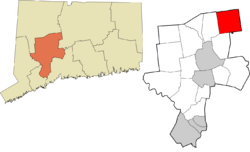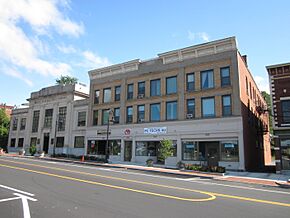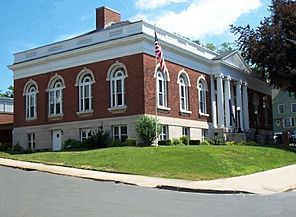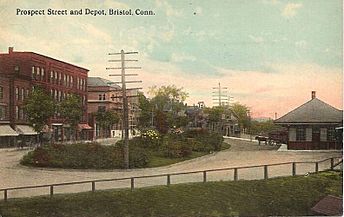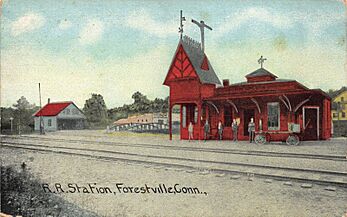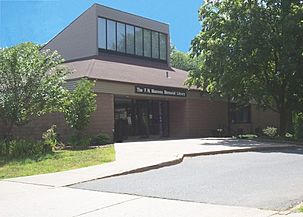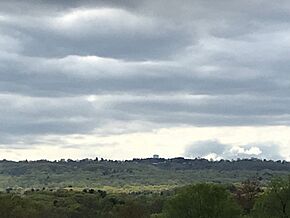Bristol, Connecticut facts for kids
Quick facts for kids
Bristol, Connecticut
|
|||
|---|---|---|---|
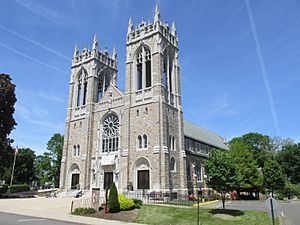
St Joseph Church, Bristol CT.
|
|||
|
|||
| Nicknames:
Mum City, Home of ESPN, Bell City
|
|||
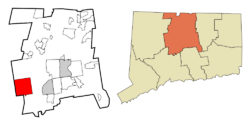 Hartford County and Connecticut Hartford County and Connecticut |
|||
| Country | |||
| State | |||
| County | Hartford | ||
| Region | Naugatuck Valley | ||
| Incorporated (town) | 1785 | ||
| Incorporated (city) | 1911 | ||
| Neighborhoods |
|
||
| Government | |||
| • Type | Mayor-council | ||
| Area | |||
| • Total | 26.81 sq mi (69.44 km2) | ||
| • Land | 26.41 sq mi (68.39 km2) | ||
| • Water | 0.40 sq mi (1.05 km2) | ||
| Elevation | 420 ft (130 m) | ||
| Population
(2024)
|
|||
| • Total | 61,892 | ||
| • Density | 2,270.20/sq mi (889.5/km2) | ||
| Time zone | UTC−5 (EST) | ||
| • Summer (DST) | UTC−4 (EDT) | ||
| ZIP Codes |
06010–06011
|
||
| Area codes | 860/959 | ||
| FIPS code | 09-08420 | ||
| GNIS feature ID | 02378270 | ||
| Major highways | |||
Bristol is a city in Hartford County, Connecticut, United States. It is about 20 miles (32 km) southwest of Hartford. The city is also about 120 miles (193 km) southwest of Boston and 100 miles (160 km) northeast of New York City. In 2020, about 61,844 people lived in Bristol.
Bristol is famous for a few things. It is home to ESPN, a big sports TV network. It also has Lake Compounce, which is the oldest theme park in the United States that is still open. Bristol was once known for making clocks in the 1800s. You can learn about this history at the American Clock & Watch Museum.
The city's nickname is "Mum City." This is because Bristol used to grow many chrysanthemum flowers. It still holds an annual Bristol Mum Festival to celebrate this.
Contents
History of Bristol, Connecticut
The land where Bristol is now was first home to the Tunxis Native American tribe. They were part of the Eastern Algonquian-speaking peoples.
Early Settlements and Growth
Bristol was originally part of Farmington, Connecticut, which became a town in 1645. The first person to settle permanently in Bristol was Ebenezer Barnes in 1727. Other settlers soon followed, building homes for farming. By 1742, families wanted their own church and local government. They formed a group called New Cambridge.
The first church was built in the area now called Federal Hill. This was chosen as the center of the settlement.
Becoming a Town and City
In 1785, New Cambridge officially became the town of Bristol. It was named after Bristol, England. Around 1790, a man named Gideon Roberts started making wooden clocks. He sold them by riding his horse through Connecticut, New York, and Pennsylvania. As his business grew, Bristol became famous for its clock-making. Other industries like brass and hardware also grew from this.
Bristol became an official city in 1911. Today, it is mostly a place where people live. It is well-known for ESPN (which started there in 1979), the American Clock & Watch Museum (since 1952), and Lake Compounce, which opened in 1846.
City Improvements
In the 1990s, Bristol started committees to make sure properties were well-kept. These groups helped keep the city looking nice. In 2008, a new committee was formed to help with building appearance and safety.
Also in 2008, Bristol began to improve its downtown area. An old shopping mall was bought and torn down. This created a new space called Depot Square for future development. Streets were also improved with new lighting and brick medians.
Geography of Bristol
Bristol covers about 26.81 square miles (69.44 sq km). Most of this area is land, with a small amount of water. The city has different parts, like Cedar Lake, Chippens Hill, Edgewood, and Forestville. Most of Bristol is residential, meaning people live there. However, there has been a focus on adding more businesses since 2008.
Forestville was once a hunting ground for the Tunxis tribe. It became a village in 1833 and was named for its many trees. Today, Forestville is a busy area with neighborhoods and local shops. It has its own library, post office, and parks.
Population of Bristol
| Historical population | |||
|---|---|---|---|
| Census | Pop. | %± | |
| 1790 | 2,462 | — | |
| 1800 | 2,722 | 10.6% | |
| 1810 | 1,428 | −47.5% | |
| 1820 | 1,362 | −4.6% | |
| 1830 | 1,707 | 25.3% | |
| 1840 | 2,109 | 23.6% | |
| 1850 | 2,884 | 36.7% | |
| 1860 | 3,436 | 19.1% | |
| 1870 | 3,788 | 10.2% | |
| 1880 | 5,347 | 41.2% | |
| 1890 | 7,382 | 38.1% | |
| 1900 | 6,268 | −15.1% | |
| 1910 | 9,527 | 52.0% | |
| 1920 | 20,620 | 116.4% | |
| 1930 | 28,451 | 38.0% | |
| 1940 | 30,167 | 6.0% | |
| 1950 | 35,961 | 19.2% | |
| 1960 | 45,499 | 26.5% | |
| 1970 | 55,487 | 22.0% | |
| 1980 | 57,370 | 3.4% | |
| 1990 | 60,640 | 5.7% | |
| 2000 | 60,062 | −1.0% | |
| 2010 | 60,477 | 0.7% | |
| 2020 | 60,833 | 0.6% | |
| U.S. Decennial Census | |||
In 2010, Bristol had 60,477 people living there. There were about 25,189 households. The city's population is mostly White, with smaller groups of African American, Hispanic, and Asian people.
The average age in Bristol in 2000 was 38 years old. About 23.2% of the population was under 18. The median income for a household in 2010 was $57,610.
Economy and Jobs
Bristol has several important companies that provide many jobs. These companies, along with Bristol Hospital, are the biggest private employers in the area.
Major Companies in Bristol
- Associated Spring: This company, founded in 1857, makes metal parts and supplies for many different industries.
- ESPN: The well-known sports network has its main studios in Bristol. It is the largest taxpayer in the city.
- Otis Elevator Company: This company has the tallest elevator test tower in the United States right here in Bristol. It is 383 feet (117 meters) tall and can be seen from far away.
Top Employers in Bristol
Here are some of the biggest employers in Bristol as of 2019:
| # | Employer | # of Employees |
|---|---|---|
| 1 | ESPN | 4,200 |
| 2 | City of Bristol & Board of Education | 1,601 |
| 3 | Bristol Health | 1,160 |
| 4 | Faneuil, Inc | 350 |
| 5 | Amazon | 350 |
| 6 | Sheriden Woods Health Care Center | 200 |
| 7 | IDEX Health & Science LLC | 175 |
| 8 | Stop & Shop | 150 |
| 9 | Quality Coils | 125 |
| 10 | The Pines at Bristol | 115 |
Arts and Culture
Bristol hosts an annual street festival in September. It includes a car show and a family farms weekend.
Mum Festival and Parade
The first Bristol Mum Festival started in 1962. It included a parade and was first called the "Fall Festival." In 1963, the name was changed to include "Mum" because Bristol was famous for growing chrysanthemum flowers. Before 1986, nurseries in Bristol grew over 80,000 mum plants.
Other Fun Places to Visit
Bristol has many museums and attractions:
- The American Clock & Watch Museum
- Imagine Nation, A Museum Early Learning Center
- Bristol Military Memorial Museum
- Bristol Historical Society Museum
- Witch's Dungeon Classic Movie Museum
- The Harry Barnes Memorial Nature Center
There is also a Polish-American Dożynki festival every September at St Stanislaus Church.
Sports in Bristol
Bristol has a summer college baseball team called the Bristol Blues. They play their games at Muzzy Field.
Muzzy Field is one of the oldest baseball parks in the United States. It has been updated with renovations.
Bristol also hosts the Little League New England and Mid-Atlantic Regional playoffs every August. These games take place at the A. Bartlett Giamatti Little League Center.
Parks and Recreation
Bristol has several parks for outdoor fun, including Peck, Page, Rockwell, Bracket, Barnes Nature Center, Indian Rock, and Forestville Memorial.
The city is also home to Lake Compounce, which opened in 1846. It is the oldest amusement park in North America that is still running. You can also visit the New England Carousel Museum in Bristol.
Education in Bristol
Bristol's public school system includes seven elementary schools (for grades K-5), two middle schools (for grades 6-8), and two high schools. There are also three private Catholic Schools and one Lutheran School. These private schools offer education from pre-kindergarten to grade 8, plus one high school.
Students in Bristol have shown good results on the Connecticut Academic Performance Test. This is a statewide test for tenth graders. More than 87% of Bristol students scored well on this test.
Schools in Bristol
| Elementary schools | Middle schools | K-through-8 schools | High schools | ||||
|---|---|---|---|---|---|---|---|
| Bingham School (closed June 2010) |
Chippens Hill Middle School | Saint Anthony School (Closed June 2016) |
Bristol Central High School | ||||
| Edgewood School | Memorial Boulevard Middle School (Closed June 2012) |
Saint Matthew School [1] | Bristol Eastern High School | ||||
| Greene-Hills School | Northeast Middle School | Saint Joseph School | St. Paul Catholic High School | ||||
| Hubbell School | Immanuel Lutheran School | ||||||
| Ivy Drive School | |||||||
| Jennings School (closed June 2012) |
Mountain View School | ||||||
| O'Connell School (closed June 2012) |
|||||||
| South Side School | |||||||
| Stafford School | |||||||
| West Bristol School |
There have been talks about changing the school system in Bristol. Some schools are in old buildings, so new schools are being considered. One idea is to change the system so that all schools are either K-8 or high schools, removing the middle school category.
Media
The local daily newspaper in Bristol is The Bristol Press. You can also find town news in a weekly paper called the Bristol Observer.
Transportation
Bus Service
Bristol has a bus service that connects different parts of the city. It is part of the CTtransit system, which serves the larger Hartford area.
Notable People from Bristol
Many interesting people have come from Bristol:
- Amos Bronson Alcott (1799–1888): A teacher and writer, and the father of author Louisa May Alcott.
- John R. Broderick (born 1957): The president of Old Dominion University.
- Gary Burghoff (born 1943): An actor famous for playing "Radar" O'Reilly in the TV show M*A*S*H.
- Donovan Clingan (born 2004): A professional basketball player for the Portland Trail Blazers.
- Bob Crane (1928–1978): An actor who starred in Hogan's Heroes. He worked at a radio station in Bristol early in his career.
- Chris Denorfia: A former Major League Baseball outfielder.
- Frank Filipetti: A music producer.
- Amethyst: A drag queen who grew up in Bristol.
- Michelle Guerette (born 1980): An Olympic athlete.
- Aaron Hernandez (1989–2017): A former NFL tight end for the New England Patriots.
- Gordon J. Humphrey (born 1940): A former U.S. Senator from New Hampshire.
- Cliff Johnson: The creator of the game The Fool's Errand.
- Karen Josephson (born 1964) and Sarah Josephson (born 1964): Twin sisters who won Olympic medals in synchronized swimming.
- Jocelin Donahue (born 1981): An actress known for her role in The House of the Devil.
- Fred Lynn: A famous baseball player who played for the Bristol Red Sox.
- Scott Perkins (born 1980): An American composer.
- Steve Pikiell (born 1967): A college basketball coach.
- Mike Reiss (born 1959): A longtime writer for The Simpsons.
- Albert Rockwell (1862–1925): An inventor and industrialist who designed doorbells, bicycle brakes, and other items.
- Katharine Shepard (1905–1986): An archaeologist and art historian.
- Michelle Theriault (born 1986): A stock car racing driver.
- Adrian Wojnarowski: A well-known sports journalist for ESPN.
Sister Cities
Bristol has one sister city:
- Kozani, Greece
Gallery
-
Mountains, seen from Bristol, near the Burlington border
See also
 In Spanish: Bristol (Connecticut) para niños
In Spanish: Bristol (Connecticut) para niños




